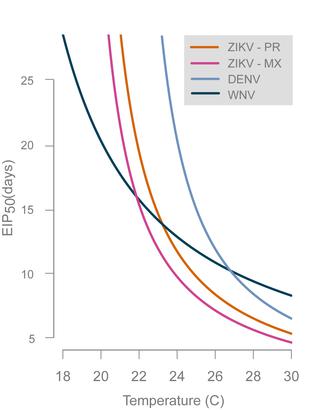当前位置:
X-MOL 学术
›
PLOS Negl. Trop. Dis.
›
论文详情
Our official English website, www.x-mol.net, welcomes your
feedback! (Note: you will need to create a separate account there.)
Impact of temperature on the extrinsic incubation period of Zika virus in Aedes aegypti.
PLOS Neglected Tropical Diseases ( IF 3.4 ) Pub Date : 2020-03-18 , DOI: 10.1371/journal.pntd.0008047 Olivia C Winokur 1, 2 , Bradley J Main 1 , Jay Nicholson 1 , Christopher M Barker 1
PLOS Neglected Tropical Diseases ( IF 3.4 ) Pub Date : 2020-03-18 , DOI: 10.1371/journal.pntd.0008047 Olivia C Winokur 1, 2 , Bradley J Main 1 , Jay Nicholson 1 , Christopher M Barker 1
Affiliation

|
Since Zika virus (ZIKV) emerged as a global human health threat, numerous studies have pointed to Aedes aegypti as the primary vector due to its high competence and propensity to feed on humans. The majority of vector competence studies have been conducted between 26-28°C, but arboviral extrinsic incubation periods (EIPs), and therefore transmission efficiency, are known to be affected strongly by temperature. To better understand the relationship between ZIKV EIPs and temperature, we evaluated the effect of adult mosquito exposure temperature on ZIKV infection, dissemination, and transmission in Ae. aegypti at four temperatures: 18°C, 21°C, 26°C, and 30°C. Mosquitoes were exposed to viremic mice infected with a 2015 Puerto Rican ZIKV strain, and engorged mosquitoes were sorted into the four temperatures with 80% RH and constant access to 10% sucrose. ZIKV infection, dissemination, and transmission rates were assessed via RT-qPCR from individual mosquito bodies, legs and wings, and saliva, respectively, at three to five time points per temperature from three to 31 days, based on expectations from other flavivirus EIPs. The median time from ZIKV ingestion to transmission (median EIP, EIP50) at each temperature was estimated by fitting a generalized linear mixed model for each temperature. EIP50 ranged from 5.1 days at 30°C to 24.2 days at 21°C. At 26°C, EIP50 was 9.6 days. At 18°C, only 15% transmitted by day 31 so EIP50 could not be estimated. This is among the first studies to characterize the effects of temperature on ZIKV EIP in Ae. aegypti, and the first to do so based on feeding of mosquitoes on a live, viremic host. This information is critical for modeling ZIKV transmission dynamics to understand geographic and seasonal limits of ZIKV risk; it is especially relevant for determining risk in subtropical regions with established Ae. aegypti populations and relatively high rates of return travel from the tropics (e.g. California or Florida), as these regions typically experience cooler temperature ranges than tropical regions.
中文翻译:

温度对埃及伊蚊寨卡病毒外源潜伏期的影响。
自从寨卡病毒(ZIKV)成为全球人类健康威胁以来,大量研究指出埃及伊蚊因其高能力和以人类为食的倾向而成为主要媒介。大多数载体能力研究是在 26-28°C 之间进行的,但众所周知,虫媒病毒的外源潜伏期 (EIP) 以及传播效率受温度的强烈影响。为了更好地了解 ZIKV EIP 与温度之间的关系,我们评估了成年蚊子暴露温度对 ZIKV 感染、传播和伊蚊传播的影响。埃及伊蚊的四种温度:18°C、21°C、26°C 和 30°C。将蚊子暴露于感染了 2015 年波多黎各 ZIKV 病毒株的病毒血症小鼠,将充血的蚊子分为四种温度,相对湿度为 80%,并持续接触 10% 蔗糖。根据其他黄病毒 EIP 的预期,在 3 至 31 天的每个温度的 3 至 5 个时间点,通过 RT-qPCR 分别对个体蚊子的身体、腿和翅膀以及唾液评估 ZIKV 感染、传播和传播率。通过拟合每个温度的广义线性混合模型来估计每个温度下从 ZIKV 摄入到传播的中位时间(中位 EIP、EIP50)。 EIP50 范围为 30°C 下的 5.1 天到 21°C 下的 24.2 天。 26°C 时,EIP50 为 9.6 天。在 18°C 时,到第 31 天只有 15% 传播,因此无法估计 EIP50。这是首批描述温度对伊蚊 ZIKV EIP 影响的研究之一。埃及伊蚊,也是第一个基于以活的病毒血症宿主为食的蚊子来做到这一点的人。 这些信息对于对 ZIKV 传播动态进行建模以了解 ZIKV 风险的地理和季节限制至关重要;它对于确定已确定的AE的亚热带地区的风险尤其重要。埃及人口和从热带地区(例如加利福尼亚州或佛罗里达州)返回旅行的比率相对较高,因为这些地区通常比热带地区经历较低的温度范围。
更新日期:2020-03-19
中文翻译:

温度对埃及伊蚊寨卡病毒外源潜伏期的影响。
自从寨卡病毒(ZIKV)成为全球人类健康威胁以来,大量研究指出埃及伊蚊因其高能力和以人类为食的倾向而成为主要媒介。大多数载体能力研究是在 26-28°C 之间进行的,但众所周知,虫媒病毒的外源潜伏期 (EIP) 以及传播效率受温度的强烈影响。为了更好地了解 ZIKV EIP 与温度之间的关系,我们评估了成年蚊子暴露温度对 ZIKV 感染、传播和伊蚊传播的影响。埃及伊蚊的四种温度:18°C、21°C、26°C 和 30°C。将蚊子暴露于感染了 2015 年波多黎各 ZIKV 病毒株的病毒血症小鼠,将充血的蚊子分为四种温度,相对湿度为 80%,并持续接触 10% 蔗糖。根据其他黄病毒 EIP 的预期,在 3 至 31 天的每个温度的 3 至 5 个时间点,通过 RT-qPCR 分别对个体蚊子的身体、腿和翅膀以及唾液评估 ZIKV 感染、传播和传播率。通过拟合每个温度的广义线性混合模型来估计每个温度下从 ZIKV 摄入到传播的中位时间(中位 EIP、EIP50)。 EIP50 范围为 30°C 下的 5.1 天到 21°C 下的 24.2 天。 26°C 时,EIP50 为 9.6 天。在 18°C 时,到第 31 天只有 15% 传播,因此无法估计 EIP50。这是首批描述温度对伊蚊 ZIKV EIP 影响的研究之一。埃及伊蚊,也是第一个基于以活的病毒血症宿主为食的蚊子来做到这一点的人。 这些信息对于对 ZIKV 传播动态进行建模以了解 ZIKV 风险的地理和季节限制至关重要;它对于确定已确定的AE的亚热带地区的风险尤其重要。埃及人口和从热带地区(例如加利福尼亚州或佛罗里达州)返回旅行的比率相对较高,因为这些地区通常比热带地区经历较低的温度范围。











































 京公网安备 11010802027423号
京公网安备 11010802027423号